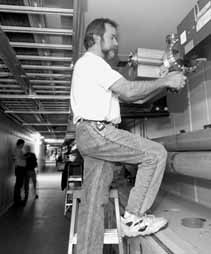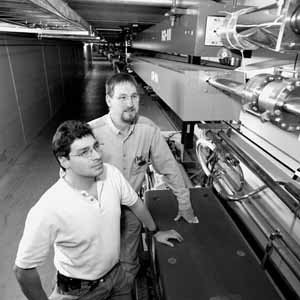 |
|
Antiprotons Join the RECYCLING Effort by Kurt Riesselmann
To the ubiquitous arrays of recycling bins labeled Cans Only, Bottles Only and Paper Only, Fermilab now adds its own unique category: Antiprotons Only.
Traveling near light speed, antiprotons dashed for the first time through the two-mile circular pipe of Fermilab's newest storage ring, the Antiproton Recycler, on Monday, November 6, 2000.
Designed to reclaim "used" antiprotons and store them for more than ten hours to be used again, the Antiproton Recycler is an integral part of Fermilab's plan to produce 20 times more proton-antiproton collisions in the Tevatron than were created in Run I. The Recycler will save time and money and expand the lab's Run II experimental reach by taking antiprotons previously discarded after being run through the Tevatron, and using them again. The Recycler is expected to contribute a factor 2.5 in the number of particle collisions, a significant step in increasing the chance that the Tevatron will produce the Higgs particle, the key to understanding the origin of mass.
The eighth-largest particle machine ever built, the Recycler is the only one of its kind. While its cousins accelerate particles to higher and higher energies, the Recycler will store and condense antiproton beams, keeping the beam energy at a steady 8 GeV. This fundamental difference allowed physicists Gerry Jackson and Bill Foster to propose the use of permanent magnets, and the Recycler ranks as the world's largest assembly of permanent magnets.
The beam then will be reshaped and replenished with additional antiprotons. Shape and density are important properties of particle beams. They are critical to the number of collisions produced when two beams collide. Once injected into the Tevatron, the quality of a beam deteriorates over time, making it less likely that inter-actions will take place. After circulating for many hours, the proton and antiproton beams become too diffuse and are discarded.
Not any longer. With the Recycler, Fermilab will be able to save the hard-to-make antiproton beams and use them again.
The Recycler ring is located underground in a tunnel also housing the Main Injector, the new accelerator that transfers particles to the Tevatron. (see "The Main Injector Issue," FERMINEWS, Vol. 22, No. 11, June 1, 1999). During the construction of the Main Injector, project manager Steve Holmes realized that the contingency funding for the project was great enough to invite an expanded vision.
Physicists suggested using the extra money to enhance the Tevatron's future. With space to spare in the Main Injector tunnel, Foster and Jackson proposed adding the Antiproton Recycler. DOE approved the plan in February 1997, before the completion of Main Injector construction.
The work on the Recycler was carried out in the spirit of Robert Wilson, Fermilab's founding director. Cutting back on desirable but expensive equipment, scientists designed a storage ring at a minimal cost. At the end, the construction of the Recycler under project manager Gerry Jackson's leadership cost less than $15 million, far less than any comparable machine, and using only about three-fourths of the contingency funding available.
"There were many adventurous things about the design of the Recycler, besides the use of the permanent magnets," said Foster. "Most of them worked well for example Gerry's design of the vacuum system, which is half the price of the Main Injector vacuum system and produces 100 times better vacuum. There were also other places where we did things on the cheap ñ and got nailed to the wall."
For example, to save cost, the Recycler has only about one-tenth the number of orbit corrector magnets of typical machines. However, when combined with a lack of adequate beam monitoring equipment, the low number of correctors left physicists feeling as if they were blindly shooting particles down the beam pipe. Improvements to the beam monitors and correctors have remedied the situation.
The first particles circulated in the Recycler in the fall of 1999, when physicists tested the new machine with protons. With the same mass and opposite electric charge, protons can travel through the Recycler in the opposite direction of antiprotons.
"We have lots of protons to use for commissioning," said Shekhar Mishra, head of the Main Injector department, who leads the commissioning of both Main Injector and Recycler. "We can put in a beam of protons every three seconds. But antiprotons take much longer to produce, cool and transfer."
Even using the improved antiproton source, Fermilab would need more than two billion years to produce just one gram of antiprotons. So, to save time and money, most of the commissioning work of the past year has relied on protons. Only after good results with proton beams did physicists decide to introduce antiprotons.
"We have come a long way in the last six months," said Mishra. "It has been an enormous effort by lots of Beams Division staff in software, instrumentation and alignment. Besides Dave and Cons, several Main Injector physicists, including Ming-Jen Yang, Krish Gounder, Stan Pruss and Martin Hu to name a few, are working hard to understand the new machine. Many other departments, including RF&I, Controls, Mechanical, EE, Operations and Alignment Group of PPD have been working very hard on the Recycler. It is rather remarkable the way everyone has come together to make the Recycler work."
Dave Johnson, who has worked with Jackson and Mishra on the design of the magnet configuration, admires the interplay of the different groups.
"It has to work like gears cogged together," he said. "The different accelerators and the people behind them are all so dependent on each other."
At present, moving particles around and transferring them from one accelerator to another requires a lot of manual coordination. To improve operations, Mishra's team has to upgrade the magnet configuration and alignment and install more correcting magnets and new shielding. Working on a tight budget and with few people, Mishra expects to have the Recycler ready in Summer 2001. To complete the work as early as possible, commissioning will continue through the Christmas holidays.
"When all accelerators are commissioned, we can flip a switch and the beam should just go around," said Gattuso, who formerly worked in the Main Control Room as an operator, flipping the very switches whose functions he now helps design.
"There are a lot of major hurdles that still need to be crossed," Gattuso said. "But things are starting to come together." |
| last modified 12/15/2000 email Fermilab |
FRLsDFx9eyfrPXgV
 "Previously, at least 75 percent of the antiprotons were still circulating when the beam density became insufficient and the beam had to be discarded from the Tevatron," explained Cons Gattuso, one of about 15 scientists presently working on the Recycler. "In the future, the Tevatron will send the antiproton beam back to the Main Injector, and from there into the Recycler."
x
"Previously, at least 75 percent of the antiprotons were still circulating when the beam density became insufficient and the beam had to be discarded from the Tevatron," explained Cons Gattuso, one of about 15 scientists presently working on the Recycler. "In the future, the Tevatron will send the antiproton beam back to the Main Injector, and from there into the Recycler."
x
 The commissioning of the Recycler, the art of tuning it to achieve the design performance, is still in progress. If Gattuso and his colleagues achieve their goal, Fermilab's beam operators will be able to inject a new high-density antiproton beam into the Tevatron approximately every eight hours. In the past, stores were kept for nearly 24 hours.
The commissioning of the Recycler, the art of tuning it to achieve the design performance, is still in progress. If Gattuso and his colleagues achieve their goal, Fermilab's beam operators will be able to inject a new high-density antiproton beam into the Tevatron approximately every eight hours. In the past, stores were kept for nearly 24 hours.